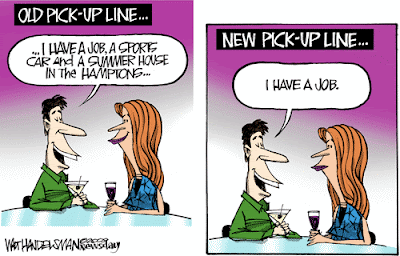Is the Taylor rule the right tool for discussing the stance of monetary policy at present?My guess is probably not. For starters, it assumes the parameters defining the relationship between the macroeconomic variables (inflation gap, output gap) and the appropriate federal funds interest rate are constant and linear. While these assumptions worked for the relatively stable 25 or so years during the Great Moderation they seem suspect now given the severity of the economic downturn. Another problem in using the Taylor Rule is that one has to know what is the neutral federal funds rate and the output gap. These metrics are hard to know with precision even in normal times, let alone turbulent economic times as we have now.
Given these challenges with the Taylor Rule, let me suggest an alternative, simple metric for determining the stance of monetary policy. This metric is difference between (1) the growth rate of nominal spending in the U.S. economy and (2) the federal funds rate. Using this metric, the federal funds rate should not deviate too far from the nominal spending growth rate otherwise monetary policy is either too loose (the federal funds rate is significantly below the nominal spending growth rate) or too tight (the federal funds rate is significantly above the nominal spending growth rate). This measure is similar to the one used by The Economist magazine where they gauge the stance of monetary policy by looking at the difference between the nominal GDP growth rate and the federal funds rate. The Economist explains the way to “interpret this [metric] is to see America’s nominal GDP growth as a proxy for the average return on American Inc. If the return is higher than the cost of borrowing, investment and growth will expand [and vice versa].
I however, think, a better way to think about this measure is to view it in terms of nominal spending rather than the return on American Inc. Here is why: stabilizing nominal spending is the key to stabilizing macroeconomic activity. If an economy is running near full employment, then any sudden increase or decrease in nominal spending will give rise to changes in real economic activity that cannot be sustained. This is because there are numerous nominal rigidities that prevent prices from adjusting instantly. There is simply no way to suddenly jar nominal spending and not have real economic activity move as well. Note, that key here is not to aim for price stability, but to aim for nominal spending stability. As I noted before,
Nominal spending shocks, after all, are the real source of macroeconomic volatility while inflation is merely a symptom of these shocks. Moreover, inflation can sometimes can be hard to interpret--Is the high(low) inflation due to positive(negative) aggregate demand shocks or negative(positive) aggregate supply shocks?--and as a result monetary policy that targets inflation may make the wrong call.The good news is that the Fed can largely shape nominal spending and keep it growing around some target. But to do so means the Fed must not let its federal funds rate be low relative to the growth rate of nominal spending or vice versa.
So what does this policy rate gap look like? Using final sales to domestic purchasers as my measure of nominal spending, I have constructed it two ways: (1) the year-on-year percent change in nominal spending minus the federal funds rate and (2) the annualized quarterly percent change in nominal spending minus the federal funds rate. I have graphed both series below with the NBER recessions in gray bars. The figure goes through 2009:Q1. (Click on the figure to enlarge.)

This figure indicates this measure is consistent with commonly held views about the stance of monetary policy historically. For example, the easing of policy in the 1970s is apparent as is the tightening in the early 1980s. This figure also shows a very accommodative monetary stance in the early-to-mid 2000s. Finally, it shows that through the last few quarters ending in 2009:Q1 monetary policy appears to have been effectively tightening. This is because even though the federal funds rate did not change, nominal spending collapsed creating a large gap between the two series. The fall in nominal spending can seen in the figure below. (Click on figure to enlarge.)
 While the policy rate gap is probably not a perfect measure of monetary policy's stance, it is simple to construct and has some predictive power as seen in the figure below. In this figure, the policy rate gap is graphed along with the CBO output gap 3 quarters ahead.
While the policy rate gap is probably not a perfect measure of monetary policy's stance, it is simple to construct and has some predictive power as seen in the figure below. In this figure, the policy rate gap is graphed along with the CBO output gap 3 quarters ahead. The policy rate gap appears to granger cause the CBO output gap. Such a pattern in the data could easily be explained by macro model where nominal spending shocks that encounter nominal rigidities create create output gaps. I find this to be a promising way to evaluate the stance of monetary policy and hope to do more with it.
The policy rate gap appears to granger cause the CBO output gap. Such a pattern in the data could easily be explained by macro model where nominal spending shocks that encounter nominal rigidities create create output gaps. I find this to be a promising way to evaluate the stance of monetary policy and hope to do more with it. 




